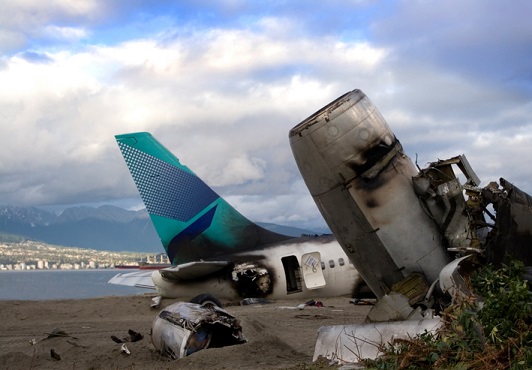Aviation Risks: Insuring A Catastrophe
It is widely considered that flying is the safest way to travel. However with the recent frequency of air-related incidents, how does the aviation industry protect itself against a major catastrophe?
Plane crashes are generally quite rare which is why media coverage always seems heightened during a significant event. Some of the more recent in-flight incidents have been more notable than others which raises the issues of how do aviation companies protect themselves in the event of an accident, who is to blame when something major occurs and how can further mishaps be avoided in the future?

The most notorious air-related incidents of recent times are those concerning two separate Boeing 777 flights operated by Malaysia Airlines in 2014. The first was the disappearance of the Malaysia Airlines Flight MH370 as it flew from Kuala Lumpur to Beijing. The aircraft completely vanished from trace mid-flight, including its 239 passengers and crew, with only a few suspected pieces of wreckage discovered since during a search of the Indian Ocean. The second occurred several months later with the shooting down of Malaysia Airlines Flight MH17 by suspected pro-Russia rebels in Serbia, killing all 298 passengers and crew, as the flight flew from Amsterdam to Kuala Lumpur. Blame cannot be absolutely determined in either case, which complicates insurance settlements as investigations are inconclusive.
More recently there has been an increase in the number of high profile aviation-related incidents:
· crash of Saratov Airlines flight near Moscow on 11 February 2018 killing all 71 people on board
· crash of Aseman Airlines flight in Iran on 18 February 2018 killing all 66 people on board
· crash of Turkish private jet in Iran on 11 March 2018 killing all 11 people on board
· helicopter crash in New York City on 11 March 2018, the third from Liberty Helicopters in 11 years
· flight BS211 veered off the runway after trying to land at airport in Nepal on 12 March 2018, killing 49 people with 22 more in critical condition
· freight of gold fell out of a Russian AN-12 transport plane after the hatch in the hold became loose
Despite the statistics stating that air travel is still safer than by road or water, when something goes wrong mid-flight, it goes VERY wrong. Considering that when a commercial or private aircraft crashes most can result in 100% fatalities, total loss of cargo and the destruction of very expensive aircraft, what insurance is available for the carrier and what does it cover? The most common types of claim are usually a result of:
· plane crash
· damage caused by ground handling
· mechanical failures
· hard landings of aircraft
· over/undershot runway/taxiway
· damage from a foreign object
Insuring aviation-related risk areas can prove complicated and costly. As well as paying out claims against loss or damage to airlines, insurers may also have to provide compensation to bereaved families. Airline operators not only need to protect their aircraft but also the liability to passengers and third parties, a process that can take years after the original incident.
In the result of a catastrophic loss, many aerospace insurers contribute a proportion of the overall insurance market as payouts can exceed billions of dollars. While being a competitive market, insurers will not handle the entire claim. They do this by either sharing part of the risk or the overall claim as a reinsurance policy with other insurers. Typical areas of aviation coverage currently offered that some insurers may prefer to combine include:
· aircraft hull and aircraft liability: this concerns any damage to the hull or aircraft both while the plane is parked (ground risk hull – non-motion) or while the plane is on ground but in motion during takeoff or taxi (ground risk hull – motion)
· aviation liability: coverage for risk areas associated with airports and aviation operations such as public liability, commercial general liability and passenger liability
· aviation products liability: coverage for components used in aircraft or other aviation products
· aviation cargo: coverage for losses or physical damage to cargo while in transit or in flight
· aircraft crew and personal accident: coverage for bodily injury or death to a member of aircraft crew
· hangar keeper’s liability: coverage for damages caused to objects of customers entrusted to the insured party (including aircraft)
· in-flight: aircraft coverage for all phases of flight and ground operation, including while parked or stored
· passenger liability: bodily injury coverage for passengers who are injured or killed during a flight
· war and terrorism: coverage in case of a hijack, bomb threat, abduction or hostage scenario
While safety measures are improving, there is an increase in political and terrorist activities that are affecting aviation premiums. Costs are increasing as are pay outs. In order to analyse a risk and determine the price of a policy, aviation insurers must consider the following:
· type of aircraft flown
· value of aircraft
· experience of the pilot
· safety record of the aircraft and crew
· number of passengers and crew (including insuring property damage, bodily injury and death)
While air travel is still considered safe, aviation insurance is seeing growth within the industry. Costly payouts are resulting in higher premiums. However, aviation insurance is indispensable as airline operators need to make sure they have all their risk areas covered in the event of a catastrophe.
You can browse our current range of Aviation products here.
Other pages of interest:
The problem that insurance and the airline industry have in common by Insurance Business on February 15, 2018
Airlander 10 to submit 'up to £32m' insurance claim by BBC News on December 1, 2017
Britain investigates five insurance brokers over aviation business by Thomson Reuters on April 21, 2017
